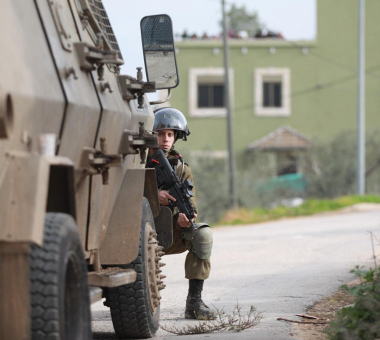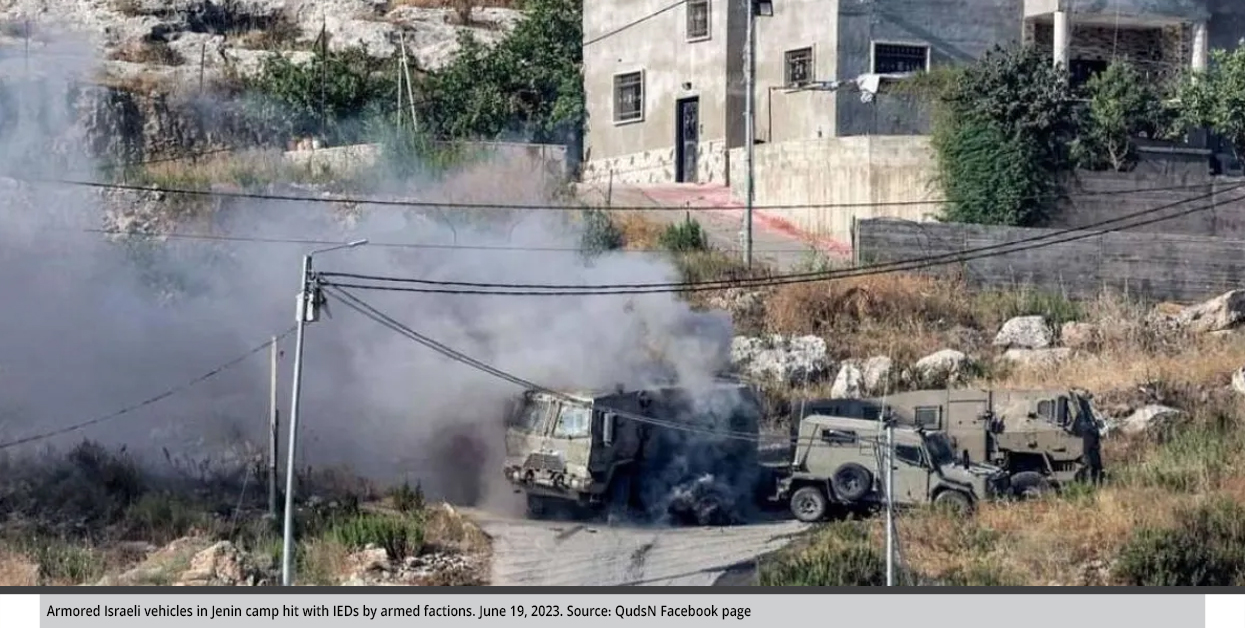What does the Development of the Palestinian Armed Factions’ Capabilities Reflect?
This assessment deals with the development of the military capabilities of the Palestinian armed factions in the West Bank. A growth in the military infrastructure of these factions may be related to attempts by non-West Bank parties to achieve a new deterrence reality against Israel.
by STRATEGIECS Team
- Release Date – Jul 5, 2023

Palestinian armed factions have shown advanced capabilities during their recent confrontations with Israeli forces, whether in their response to Israeli incursions and operations, the methods they employ during shooting attacks against settlers, or in their attempts to launch missiles towards Israeli territories.
The development of the military infrastructure of the Palestinian armed factions, specifically in the Jenin area, has become a source of concern for Israel, particularly after these factions sought to create a new reality based on deterrence. This included using highly-explosive devices against Israeli military vehicles for the first time on June 19.
Inside Israel, calls were strong to initiate a large-scale offensive attack to undermine the escalating violence between Palestinians and the Israeli army in the city of Jenin and its camp, and to curb the shooting operations targeting settlers, many of which originate from the city of Jenin. On July 3, Israel announced a large-scale invasion in Jenin and its refugee camp of nearly 1,000 soldiers and a number of vehicles and bulldozers, during which air strikes were carried out via drones. This invasion, which lasted two days, was targeted to undermine the infrastructure and weaponry of the Palestinian armed factions.
The Palestinian armed factions’ capabilities development and the scale of Israel’s recent military invasion indicate that larger parties forcefully intervened in the course of escalation and de-escalation in the West Bank. Having been provided logistic, technical, and training support, these small armed factions are no longer the same independent youth movements they were when they first emerged. Today, the performance and behavior of these factions reflect the outcome of the influence exerted over them by Hamas and Iran.
Attempts to Anchor a Military Infrastructure in the West Bank
The advanced development displayed by the Palestinian armed factions didn’t occur suddenly, rather, it was preceded by a series of indicators that they were receiving technical support and training. Such indications were demonstrated in how these factions responded to the ongoing military operations and raids on the West Bank one year ago.
First, the Palestinian armed factions have shown a notable development in making and using highly explosive devices that targeted and damaged Israeli armored vehicles during the Israeli operations in June and July.
Second, the armed factions in Jenin used intense machine gun fire that delayed Israeli incursions into the city and its camp during the invasion in early July. And on June 19, intense fire damaged an Israeli Air Force Apache attack helicopter, forcing it to make an emergency landing.
Third, The armed groups adopted new tactics in response to the recent Israeli invasion of Jenin. According to military advisor Muhammad Thalji, these tactics involve the evacuation of armed group members and their weapons from both the city and the camp, effectively preventing the Israeli forces from locating the fighters and their armaments, except for some magazines and larger projectiles that the Israeli forces could not carry. Furthermore, the armed group members demonstrate a high level of coordination during attacks, movements between locations, and when setting up ambushes. Additionally, the armed groups have developed contingency plans in case of communication disruptions and have established designated meeting points for future needs. Finally, the armed groups strategically based their military plans on precise intelligence gathered from within Israel. This element of surprise caught Israel off guard, as these groups were able to swiftly prepare the battleground, lay traps, and inflict significant losses upon the Israeli forces.
Fourth, there has been an accelerating pace of attempts to establish an infrastructure for manufacturing and launching missiles from the West Bank towards Israel. On May 9, Israel foiled an attempt by a cell affiliated with the Palestinian Islamic Jihad to establish a missile-manufacturing infrastructure in the West Bank to target Israeli territories. Another cell that planned to launch armed drones toward Israel was arrested in Ramallah. The first attempt by armed factions to launch missiles into Israeli territories was on May 24, when the armed factions fired a missile towards the illegal Israeli settlement of Shaked. The missile exploded about three meters away from the launch site in the village of Nazlat Issa near Jenin. The second attempt to launch a missile from the city of Jenin towards the settlement of Ram Aon was on June 26.
Fifth, the improvised explosive devices (IED) experiments started to extend beyond Jenin to reach other areas in the West Bank. According to local Palestinian sources, two young men were killed and a third wounded while trying to make an IED that accidentally exploded in Balata refugee camp east of Nablus.
Sixth, a shooting attack on June 20 near the settlement of Eli that killed four and injured four others revealed a qualitative shift in such operations, from being mostly executed individually and spontaneously to being pre-planned operations. This three-man operation was carried out using heavy machine gun fire and targeted two different locations.
Seventh, the vehicular and knife assault in Tel Aviv on July 4, which Hamas claimed responsibility for in retaliation for the Israeli invasion on Jenin and its camp, demonstrated how deep the incursion of armed factions are inside Israel. This incursion happened through individuals affiliated to Hamas and operating inside the Israeli territories, or through channels by which Hamas can recruit potential attackers inside Israeli cities.
Eighth, these developments indicate that the ongoing and uninterrupted Israeli military operations didn’t undermine the armed factions’ capabilities. Instead, the sense of insecurity grew among settlers in the West Bank, especially with the high number of settler and soldier casualties, which reached 29 since the beginning of 2023 compared to 26 last year.
Hamas’s Increasing Role in the West Bank
Media and organizational interest in Hamas regarding events in the West Bank increased. There is a direct link between violence in the West Bank and Hamas’s role in it. Hamas is under restrictions concerning its escalation against Israel in the Gaza Strip, particularly through Hamas tacit understandings with Israel regarding de-escalation in the Gaza front, in addition to Egypt’s pressure on Hamas to achieve that purpose. Thus, Hamas’s once secret military presence in the West Bank has become visible and widely known.
On the one hand, Hamas broke its silence on the operations it is responsible for in the West Bank when it claimed responsibility for one of the perpetrators of the shooting attack near the Eli settlement. Hamas also claimed responsibility for the March 9 attack on Dizengoff Street in Tel Aviv and its role in the Jordan Valley attack that killed three Israeli settlers on April 7, in addition to claiming responsibility for other similar operations.
On the other hand, Hamas no longer hesitates to announce its presence by releasing videos of its members in the West Bank. One footage showed members of the Izz Al-Din Al-Qassam Brigades making large stacks of explosive devices in a Jenin camp. Hamas also announced the successful entrapment of an Israeli force in an ambush while the force was storming Jenin on June 19. This is not the first time, as in 2022, the Al-Qassam Brigades published a video showing the presence of some of its fighters in the mountains of Jenin.

Growing Iranian Incursion in the West Bank
There is an increasingly notable similarity between the armed factions in Palestine and the Iranian-supported Hezbollah of Lebanon regarding defensive and offensive means and tactics. Israeli analysts and security experts warned that the West Bank will turn into a resistance enclave similar to the one in southern Lebanon. The Israeli media connected the development of armed factions using remotely detonated explosive devices in the West Bank to their widespread use by Hezbollah in southern Lebanon.
In fact, Hezbollah can transfer its IEDs technology to the Palestinian armed factions in the West Bank. Last March, Israeli sources reported that a Hezbollah operative infiltrated Israeli territory and placed an explosive device near the Megiddo junction that, according to the Israeli newspaper Haaretz, was “unusual in its size and power.”
The escalation in the Gaza Strip and the West Bank is directly and indirectly connected to the Iranian strategy called the “unity of arenas.” This strategy has been shifted from a theoretical framework into an operational one, parallel to the escalation of Iranian-Israeli tension with Tehran accusing Tel Aviv of carrying out a series of attacks inside its Iranian territory.
In conclusion, the development of the capabilities of the armed factions in Palestine is taking place at an accelerated pace, amid indicators of increased effectiveness of Hamas and the role of Lebanese Hezbollah in supporting Palestinian factions. Although these developments are still far from creating a balance of deterrence in the face of Israeli capabilities, it is difficult for Israel to undermine these developments via its ongoing military operations in the West Bank, particularly in the city of Jenin.

STRATEGIECS Team
Policy Analysis Team
 العربية
العربية